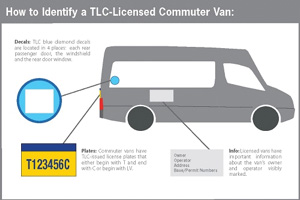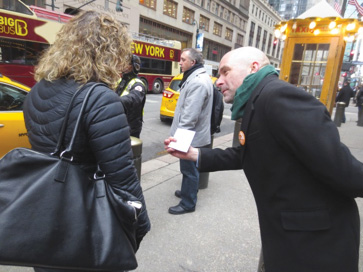|
||
By New York City Taxi and Limousine Commission Chairwoman & Chief Executive Officer Meera JoshiHello everyone… I hope you are all keeping warm during this stretch of extremely cold weather we’ve been experiencing. I’d now like to update everyone on what has been going since my last column. I want to start off by giving everyone an update on the Commuter Van decal pilot program which officially launched back in November 2014. The goal of this pilot program is to create a uniformed logo for our licensed commuter van drivers that allow passengers to easily distinguish a licensed commuter van from an unlicensed one. The TLC has been continuously working with the commuter van industry to increase the number of licensed vans involved in the pilot to maximize passengers’ awareness of this legal transportation option. Since the pilot’s launch, the TLC has signed a Memorandum of Understanding (MOU) with 34 licensed commuter van authorities who affiliate a combined 375 vans. In other words, 72% of the licensed commuter van authorities and 70% of the licensed commuter van fleets are participants in this pilot. To raise awareness about the pilot, but more specifically, licensed commuter van service in general, we have created an informational palm card that provides some of the most important information for passengers to know about spotting licensed
Driving in New York City, professional driver or not, is no easy task. This is why our licensees have a particularly difficult job when you consider how much time and how many miles they drive each and every day. Passenger and driver communication is an essential part of the taxi ride dynamic and we believe it is very important for passengers to share their priority of safety over speed with their drivers. One very We know drivers are very sensitive to their customers’ needs and there are times when a passenger will ask a driver to “step on it.” For all the taxi passengers out there reading this, please resist that urge! Like I said previously, drivers already have a very difficult job and when they are also conflicted with balancing the requests of their passengers and their desire and obligation to follow the law, it can create a stressful environment for both the driver and passenger. TLC licensees have a unique and powerful ability, though. With over 120,000 licensed drivers and 70,000 licensed vehicles, our licensees are in a position to really set the tone on our streets by driving the speed limit. If our drivers drive the speed limit, it will send a ripple effect to all other drivers who will then also have to drive the speed limit. Lastly, before I sign off this month, the TLC held a public hearing on February 12 to hear testimony from industry stakeholders regarding a licensing structure to address the ways in which for-hire vehicle (FHV) bases use smartphones applications to dispatch vehicles. An important role of the TLC is to promote innovation, accountability, customer service, safety, and consumer protection across all of our regulated industries. Holding this hearing enabled us to better understand how the various dispatching apps operate within New York City and how our licensees are using them. We received a lot of valuable feedback from those who attended the hearing and submitted written comments. We are now in the process of digesting all positions that were discussed and will culminate the information into a fair and effective proposal for a licensing framework. That’s all for now. Until next time, stay warm and drive safely!
Watch the TLC web site at www.nyc.gov/taxi for updates, or to access monthly medallion price charts. © 2015 TLC Magazine Online, Inc. |



